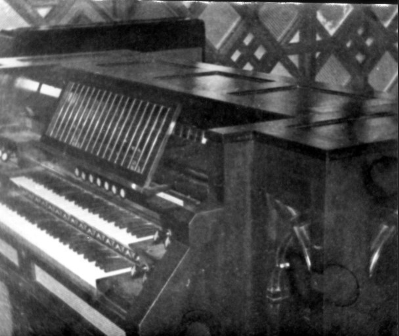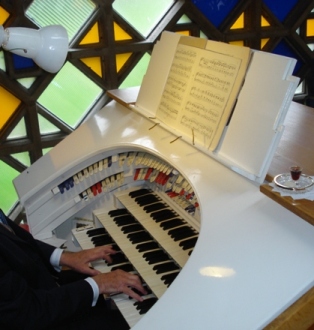History
In 1954 the Ipswich Congregational Council, represented by the Revd J M Vick of the then Crown Street Congregational Church, instructed architects to proceed with the Castle Hill Church building project. This followed the drive and dedication of Free Church people in the town and the willingness of the Borough Council to allocate a site for a church on each of the town's large housing estates. The foundation stone was laid on 8 October 1955 at a special ceremony on a drizzly Saturday afternoon, signalling the official start of construction.
On 6 October 1956 the church, which cost £16,181 11s 2d to build, was officially opened. Located on the edge of the newly extended Whitton housing estate the church looked mainly over a landscape of fields, ponds, crops, trees and rough playing areas. The location of the church is testament to the foresight of its planners because today it is strategically placed opposite a primary school and at the centre of a large, mixed housing development. In 1976 a new extension was added at a cost of £26,210.09 and was further extended in 2007 as a 50th Anniversary project. The extension is used by both the church and the local community and houses a Sports Hall, Common Room and modern kitchen.
The church's unique "tent-like" design and concrete construction led to it being classified as a Grade 2 listed building in 1998. But the design of the building is not its only unique feature. The church houses a rare 1930s cinema organ. This arrived in 1969 following an agreement between the church members and the Ipswich Light Organ Society to install the three-manual "Christie" concert organ within the church. Manufactured in 1935, the organ had been removed from a cinema in Clacton. This has led to a very close partnership between the church and the society. Now the rich tones of this superb instrument enhance both worship and the regular concerts held by the society.
In 1985, the church entered into a twinship with a church in Mussbach, Germany. This has developed into a close association with both formal and informal exchange visits taking place each year.
The Ministers
Miss Evelyn M Allford: 6 October 1956 until end of 1959
Trained as a "Home Missionary", Evelyn left to begin married life in the Merseyside area. She returned to take part in Castle
Hill's 50th Anniversary celebrations in May 2007.
Revd Don Reekie: 17 September 1960 until 3 January 1965
Don and his family left to prepare for Missionary work in Niuè, South Pacific.
Revd Brian T Sturtridge: 16 July 1966 until 1969
Brian left to take charge of two churches in rural Cambridgeshire and has now retired.
Revd Frances Chambers: 30 January 1971 until 1986
Frances retired to Worcester and kept in regular contact with our church until her death in February 2003.
Revd Richard J Mortimer: 4 April 1987 to 1995
Richard left to become part-time Minister to Wroxham URC in Norfolk, assisting the Moderator of Eastern Province in pastoral
work within Norfolk district. He was appointed Deputy General Secretary of the United Reformed Church early in 2009.
Revd Cecil E White: 29 June 1996 to 1 June 2008
Cecil left to take up a chaplaincy at Leeds University. He still keeps in regular contact with our
church. Cecil’s wife, Revd
Samantha (Sam) White was called to the Ministry while worshipping at Castle Hill URC. Sam now serves a group of
churches in the Bury St. Edmunds area of Suffolk.
Revd Pam Smith: July 2009 to October 2017
Pam retired to Leicester.
Revd David Rees: September 2018
Revd Adam Earle: July 2022
Music at Castle Hill by Pat Hicks
Looking back over 50 years, music has always been a feature of the Castle Hill congregation. We have never had a ‘choir’, but have always been able to produce a variety of music to add to the worship. From the beginning, there was a small harmonium-type organ which sat at the front and Michael Saunders was the organist.
Then, we were asked to house the magnificent cinema organ (the one at the back of the church) which utterly transformed the sound and experience of worship. Again, Michael Saunders was the man sitting on the seat. Other organists have played this organ to great effect from time to time – in fact, at one time we had a rota of players! Those days are past, but Michael continued to be its finest player until his passing.
However, that has not been our only source of music. Over the years, we have gathered groups, small and large, to perform all sorts of music, mostly singing, but also musical instruments (guitars, piano, cello, etc). A lot of us will remember taking part in large performances of Roger Jones’ musical operettas such as ‘Mary Jones and her Bible’, ‘Saints Alive’ and so on, when young and old came together to enjoy singing together ‘with a joyful sound’. We had a Music Group at one time whose job was to organise such events and plan for the year.
Now, we make music in a very different way. Oh, yes, we still sing, but a lot of the time we are blessed with the digital age and always have accompaniment from that small box which sits either at the front or rear of the congregation, masterminded by Michael Robertson, and usually played by him, or Len Green. Thanks to them, we are able to ‘sing to the Lord with a cheerful voice’ and enjoy the variety of hymns which are chosen each week.
Be thankful for all those happy memories and the people who have helped us enjoy our music over the years. When you can, sing up and ‘make a joyful noise unto the Lord’, giving yourself to the worship at Castle Hill.
 |
 |
 |
| The original organ | The Christie concert organ | A computer simulation of a real organ |
|---|---|---|
| keyboard that can play music files. | ||
| All the stops etc. can be operated | ||
| just like a ‘live’ organ. |